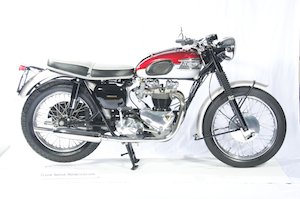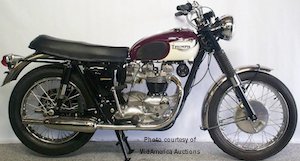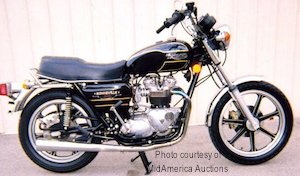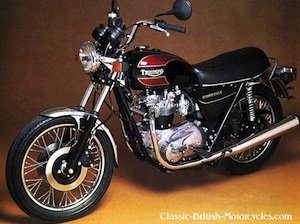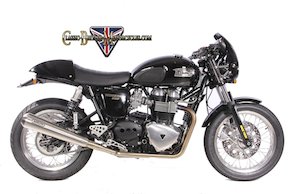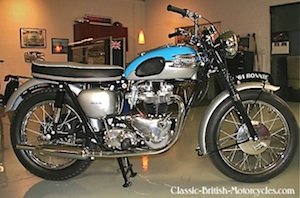ABOVE: This 1965 Triumph Bonneville represented Triumph and the Bonneville at its peak, and was one of the fastest bikes on the road in 1965. The Japanese hadn’t started building fast bikes yet, but they were coming.
BONNEVILLE BACK-STORY
While the first Bonneville hit the streets in 1959, the story hardly begins there. Triumph motorcycles and the British motorcycle industry in general were enjoying a wave of success and popularity, in the marketplace, on the racetrack and on the street. Triumph was not only the sales leader among the other British brands, but they were also leading the way in performance.
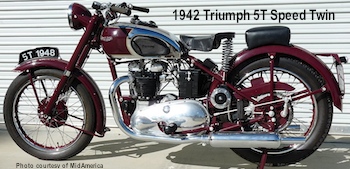
LINEAGE OF THE TRIUMPH BONNEVILLE
The 1959 Triumph Bonneville 650 wasn’t born overnight. While the first of a long line of Bonnevilles, it’s lineage can be traced back to the Triumph Speed Twin of 1937. This 500cc machine was the first true vertical twin, designed by Edward Turner, and spawned not just every Triumph twin from then on, but nearly every classic British motorcycle as well. Every year the public’s demand for more power was met by a steady list of improvements and enhancements that squeezed ever more performance out.
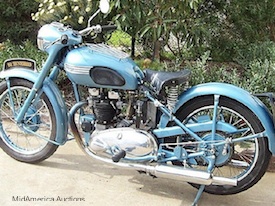
MORE POWER, SCOTTY!
By 1949, Turner decided to do a ‘bore-and-stroke-job’ on the 500. He punched the bore from 63mm to 71mm and stretched the stroke a mere 2mm, from 80mm to 82mm. The result was a 649cc road rocket called the 1950 6T Thunderbird. Next in line, in 1953, was the Tiger T110 (implying that it would do 110 mph!). Finally, in 1956, Triumph introduced the TR6 Trophy, a stripped down, off-road/competition version. But the big news for 1956 was a brand new alloy cylinder head, the “Delta Head”. Replacing the ancient iron head, the Delta offered bigger valves, better flow, better cooling and higher compression, and while it was still designed for a single carburetor, the die had been cast. Because soon, the Delta would sprout a second carb. The biggest market for Triumph motorcycles at the time was the US, and the Yanks wanted MORE POWER!! More power was on the way! The adage in those days was “Too much is almost enough”.
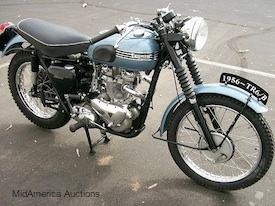
WORLD’S FASTEST!
In 1955, Johnny Allen rode his Triumph-powered ‘Texas Cee-Gar‘ streamliner to 193.30 mph on the Bonneville Salt Flats, setting the record for the world’s fastest motorcycle. NSU took the title briefly, but then Allen took it back in 1956, blasting across the salt at 214.17 mph, a record that would stand until 1962, to be taken by another Triumph-powered machine. Edward Turner wasted no time in cashing in on it, proudly proclaiming Triumphs “The World’s Fastest Motorcycles”.
DELTA HEAD & THE TR6
In 1956, the new alloy ‘Delta Head’ replaced the old cast iron cylinder head, offering reduced weight, bigger valves for better flow and improved cooling, which allowed a higher compression ratio. But all with one carburetor, as in the wildly-successful Triumph TR6 and Triumph Trophy. Twin-carb conversions were already being played with however, and soon dual-carb heads were made available to racers and the public.
BIRTH OF THE BONNIE
By 1959, the pressure was just too great and Triumph released their seminal 1959 Triumph Bonneville 650, commemorating their salt flats victories. It was designated T120, continuing the Triumph custom of intimating at a top speed. At the time, Triumph Bonneville really was the fastest bikes you could buy, nothing else could touch them! On the racetrack on on the streets, they were tops!
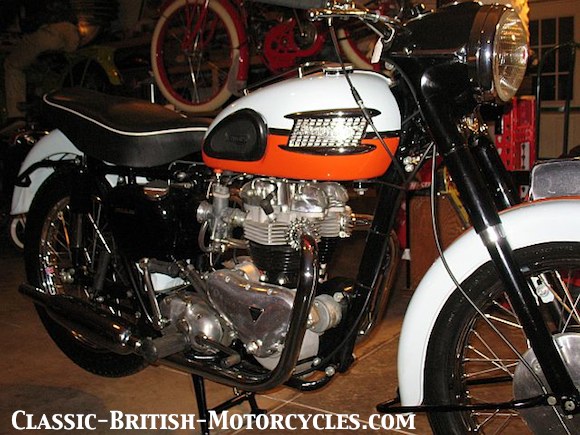
ABOVE: This 1959 Bonneville shows the full-valance mudguards and old-fashioned headlight nacelle. Not befitting one of the fastest machines on the road!
POOR STYLING
But, Triumph had made a miscalculation and misread their market. The Bonneville was introduced in 1959 with a clunky nacelled headlight and fully-valanced fenders, better suited for foul-weather riding in England. They had essentially installed a twin-carb head onto a T110 Thunderbird. What America longed for was a stripped down bike, like the Triumph TR6 Trophy, but with 2 carburetors! By 1960, they got it right in the looks department. But, they also changed the frame in 1960 to the dreaded ‘duplex’ design that flexed and cracked all the way through the 1962 model year.
UNIT CONSTRUCTION
For 1963 Triumph did a complete redesign on the venerable 650 vertical twin. Prior to this time, the crankcase, primary case and transmission were all separate components bolted together with brackets in the frame. You literally rotated the transmission back in it’s mounts to tighten the primary chain! Then you had to readjust your final drive chain again. These were called ‘Non-Unit’, or ‘Pre-Unit Construction’ engines. For 1963, Triumph put it all into one clean housing, or ‘unit’, which is called ‘Unit Construction’. It was lighter, more compact, stronger, cleaner, and now it had a proper chain tensioner. It was an instant hit! And it allowed Triumph to pull even more power out of the T120 Bonneville 650.
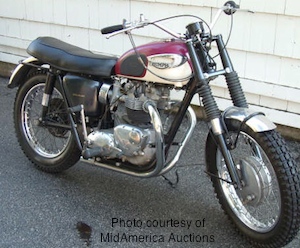
HORSEPOWER RACE IS ON
Competition really did improve the breed, in the case of Triumph motorcycles and the Bonneville in particular. Road racing in England and Europe, and desert racing, scrambles and motocross in the US stretched the 650 twin to its limits. Parts broke, new things were experimented with, as part of an ad hoc development process that pitted horsepower against vibration. The lessons learned trickled quickly down to the street models and a steady range of improvements were made nearly every year in the pursuit of the perfect balance between performance, smoothness and reliability. Not easy to get from a 1930’s design, especially in the face of fast, reliable, cheap bikes pouring out of Japan. Bikes like the Honda CB450 were just as fast (didn’t handle nearly as well, though), cheaper and totally reliable, at a time when a Triumph might leave you on the side of the road, scratching your head.
BONNEVILLE’S ZENITH
As the 1960’s closed, the Bonneville reached its zenith with the 1969 and 1970 models, widely considered the best of all the Bonnevilles, perhaps the best of all classic Triumph motorcycles. Heck, maybe even the best Classic British Motorcycle. That’s a matter of opinion, of course, but it would surely be near the top of anyone’s list.
CRUSHING COMPETITION FROM ABROAD
As the Japanese got better and faster, Bonnevilles were no longer the fastest thing on the streets. A Kawasaki 500 triple would tear it’s head off in a street fight! And a Honda 750 Four? Forget about it! British bikes, once the fastest bikes on the road, were beginning to look antiquated, quirky and irrelevant. By this time, Brit bikes had a reputation for leaking oil, vibrating so badly that parts would fall off, dicey electrics (Lucas, ‘the Prince of Darkness’), and poor reliability.
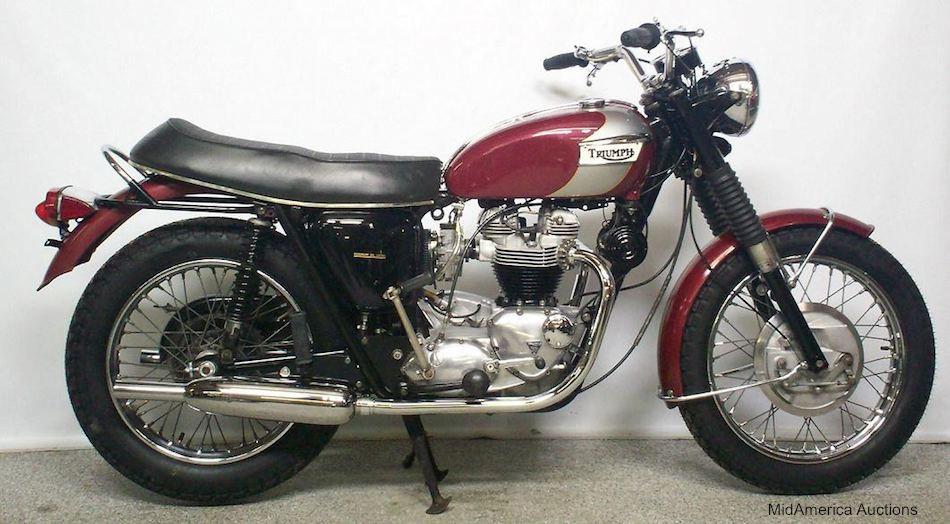
ABOVE: By 1970, Triumph had just about perfected the Bonneville, just in time to completely change them over to oil-in-frame.
BAD MANAGEMENT
Despite raging success throughout the 1960’s, Triumph needed to do a lot of work, and spend a lot of money doing it, if they were to compete in this new, changing environment. They needed 5 speeds, electric starters and disk brakes for starters. And they had to do something about all that other stuff. By this time, BSA, who had owned Triumph since 1951, began meddling, made a series of catastrophic blunders, spurred inter-brand rivalry (BSA resented Triumph’s success) and spent all the money.
OIL-IN-FRAME DEBACLE
In the face of all this, what was their answer? In 1971, Triumph & BSA came out with a common frame for their respective 650 twins, the dreaded Oil-in-the-Frame debacle of 1971. Designed by aerospace engineers who had no knowledge of motorcycles, it was the answer to the question no one was asking. Of all the things Triumph needed, the last one was a new frame! But here it was, sitting so tall in the seat that many riders couldn’t touch the ground! The massive drain-pipe of a backbone that was supposed to be filled with oil could only be filled halfway because of ‘foaming problems’, forever plaguing these “Oilers” with an inadequate oil supply. The production line had to be shut down for weeks while the blueprints were finalized, losing valuable and much-needed production. When the new frames finally did arrive, it was found that the engines couldn’t be installed, there wasn’t enough room. Suffice it to say, this kind of thinking was part of the slow-motion-train-wreck that was the British Motorcycle Industry at the time.
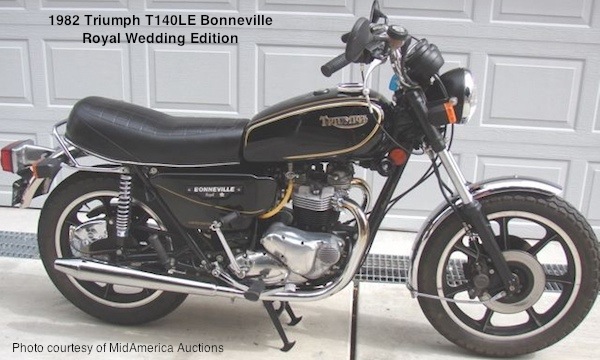
ABOVE: This 1982 Bonneville T140LE ‘Royal Wedding’ edition was built to commemorate the wedding of Prince Charles to Lady Diana. And finally, an electric starter.
SOME HOPE YET: 5-SPEED 750
Despite all this, Triumph continued to produce some wonderful machines. By 1973, they’d worked most of the bugs out of the new running gear. They punched it out to 750cc, shortened the con rods and the barrels by one fin to allow easier installation on the line, had a disk brake and a 5 speed transmission. Still no electric starter (it finally debuted in 1982), but it did retain those atrocious Lucas electrics.
THE BITTER END
The Bonneville soldiered on as a 750 until 1983, in a variety of forms and a few special editions. The classic Triumph Bonneville was literally the last British motorcycle produced by the old British motorcycle industry. Now owned by it’s workers, the forever cash-strapped Meriden Co-op struggled along, producing fewer and fewer bikes, that were more and more outclassed by the rapidly-advancing competition. Finally, the creditors liquidators swept in and shut it down for good. Well…sort of.
LES HARRIS
Billionaire British developer John Bloor bought what was left of Triumph for a song. His plan was originally to re-engineer the old bikes, but soon abandoned that idea in favor of a whole new bike. But it was still years off. So in the interim, he licensed the rights, and leased the tooling to produce the classic 750 Bonneville to Les Harris. Harris was a successful supplier of aftermarket parts for Triumph Bonnevilles. So from 1985 through 1988 he produced 1,255 Les Harris Bonnevilles in Devon, England, practically by hand. When his license expired, Bloor didn’t renew it. He had other plans…
It’s a sad story really, but the good news is that Triumph is back in business (new owners, new philosophy, new bikes, new everything!) and they’re building Bonnevilles again. Not quite like the classics we love and dream of, but a nice testament to a motorcycling legend!

ABOVE: This 2014 850 Bonneville shows how the reborn Triumph has retained the classic ‘Bonneville look’ in a totally modern bike.
REDEMPTION & RESURRECTION OF THE BONNEVILLE
John Bloor had been quietly working behind the scenes to have a whole new line of state-of-the-art 3- and 4-cylinder bikes built in an all-new factory in Hinkley, England. They engines were of modular design, built around 250cc and 300cc component sets, yielding 750 and 900 triples, and 1000 and 1200 fours starting in 1991. It took until 2001 to launch the first modern Bonneville, now an 800cc DOHC 4-valve-per-cylinder, oil-and-air-cooled twin making around 65 horsepower. It was an able performer, a solid bargain at well below $8,000 MSRP, and a really looker. Triumph as continued to build ‘Hinkley Bonnevilles’ in a variety of forms including high-performance the Thruxton factory cafe racer. Not that the Triumph Bonneville story is nearly over, but this is a very nice ‘happy ending’ to a roller coaster story full of highs and lows.
Triumph Bonneville 5 GENERATIONS, YEAR-BY-YEAR
In an effort to keep this vast amount of information organized and easy to use, we have broken the Triumph Bonneville line down into these 3 subgroups:
Bonneville
PRE-UNIT CONSTRUCTION
1959 – 1962
All Triumph 650s went Unit Construction in 1963. Prior to that, they’re all called ‘Pre-Unit’ 650s. This refers to the fact that the engine, primary case and transmission are all separate components bolted together with brackets, on the bike.
…..1959 Bonneville
…..1960 Triumph Bonneville
…..1961 Bonneville
…..1962 Bonneville
Bonneville
UNIT CONSTRUCTION
1963-1970
All Triumph 650s went Unit Construction in 1963. Engine, primary & gearbox, formerly separate components, now contained in one common case. Lighter, stronger, more compact & it looked better.
…..1963 Bonneville
…..1964 Bonneville
…..1965 Bonneville
…..1966 Triumph Bonneville
…..1967 Bonneville
…..1968 Bonneville
…..1969 Bonneville
…..1970 Bonneville
Bonneville
OIL-IN-FRAME
1971 – 1983
In 1971 all 650s received a new frame which held the oil inside its backbone, rather than in a separate oil tank, called an ‘Oil-Bearing Frame’. Along the way, they finally got disk brakes, 5 speeds & even an electric starter.
…..1971 Bonneville
…..1972 Bonneville
…..1973 Bonneville
…..1974 Bonneville
…..1975 Bonneville
…..1976 Bonneville
…..1977 Bonneville
…..1977 Bonneville Silver Jubilee
…..1978 Bonneville
…..1979 Bonneville
…..1979 T140D Bonneville Special
…..1980 Bonneville
…..1981 Bonneville
…..1982 Bonneville
…..1982-83 Triumph T140W TSS (8-valve)
…..1983 Bonneville
Les Harris Bonnevilles, 1984-89
LES HARRIS BONNEVILLES
1983-1989
When the classic Meriden plant closed, the Triumph brand was bought by John Bloor & he licensed the rights to the Bonnie to Les Harris, who hand-built them in low numbers in England until Bloor was ready to launch the new Triumph brand in 1990.
HINKLEY-TRIUMPHS
1990 to Present
The rebirth of Triumph as a builder of high-quality, state-of-the-art, high-performance motorcycles. Success at last! The Hinkley Bonneville retains the classic looks.
2008 Bonneville
2009 Bonneville Thruxton
2014 Bonneville
2016 THRUXTON
NEW VIDEO:
“TRIUMPH BONNEVILLE THRU THE YEARS”
Take a video walk through every year of classic Triumph Bonneville, from 1959 to 1983. All are taken from the same camera angle to provide some continuity.
Check out these TRIUMPH BOOKS
Triumph Motorcycles: The art of the motorcycle
The Complete Book of Classic and Modern Triumph Motorcycles 1937-Today (Complete Book Series)
Triumph Motorcycles: From Speed-Twin to Bonneville
Triumph Bonneville and TR6 Motorcycle Restoration Guide: 1956-83
British Motorcycles Triumph (Little Books)
Triumph Motorcycles in America
McQueen’s Motorcycles: Racing and Riding with the King of Cool
Triumph Motorcycle Restoration
Illustrated Triumph Motorcycles Buyer’s Guide: From 1945 Through the Latest Models (Illustrated Buyer’s Guide)
Tales of Triumph Motorcycles and the Meriden Factory
Hinckley Triumphs: The First Generation (Crowood Motoclassic)



